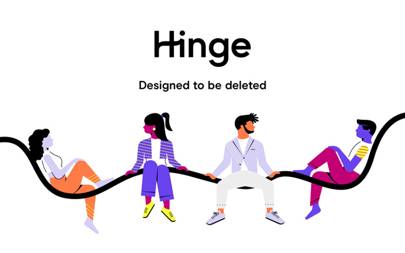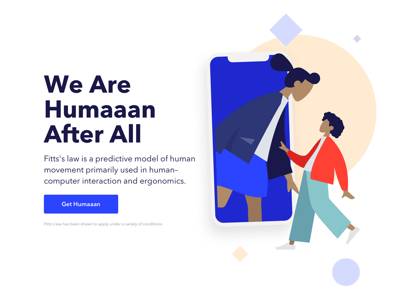

Getty Images / WIRED
The illustration style is flat, geometric, figurative, and usually made up of solid colours. Nondescript figures are plastered across train stations and bus stops, from fintech company MoneyFarm, to Trainline, to the Viagra delivery service GetEddie. Even Transport for London’s own branding, with a special place in the history of Modernist graphic design, has started to replicate the style.
It’s an aesthetic that’s often referred to as ‘Corporate Memphis’, and it’s become the definitive style for big tech and small startups, relentlessly imitated and increasingly parodied. It involves the use of simple, well-bounded scenes of flat cartoon figures in action, often with a slight distortion in proportions (the most common of which being long, bendy arms) to signal that a company is fun and creative. Corporate Memphis is inoffensive and easy to pull off, and while its roots remain in tech marketing and user interface design, the trend has started to consume the visual world at large. It’s also drawing intense criticisms from those within the design world.
“It really boils my piss to be honest,” says Jack Hurley, a Leeds-based illustrator who says his main output is “daft seaside posters.” Hurley was familiar with the style from Facebook’s login page, but had started to see the illustrations, with their sensible, slightly strange characters, while walking around his neighbourhood as well. “I live in a student area and there are some real scumbag letting agents,” he says. “Suddenly they’ve got all this marketing with the bendy-arm-people.”
Corporate Memphis has been particularly popular in the fintech and property sectors. For small companies looking to stand out, the quirky, digital-first style of Corporate Memphis is an easier solution than stock imagery. But it has contributed to a massive homogenisation and dulling down of the internet’s visual culture. Corporate Memphis “makes big tech companies look friendly, approachable, and concerned with human-level interaction and community – which is largely the opposite of what they really are,” says tech writer Claire L. Evans, who began collecting examples of the style on an are.na image board in 2018.


“From a design point of view, it’s pretty lazy,” says Hurley. “Adobe Illustrator, in particular, that’s sort of the culprit.” Illustrator’s tools allow for easy manipulation of clean lines and colours, allowing them to be edited as scalable vector graphics (SVGs). From there, it’s easy to animate and to replicate the illustrations across platforms.
Hurley sells his seaside posters and postcards at craft fairs – a few years ago he might have been complaining about the glut of owls and foxes wearing monocles, but now the style has changed. “One thing that I’ve just noticed over the last couple of years, is the big red circles or red cheeks,” he says. Corporate Memphis has infected the folksy British craft scene, with simple shapes, untextured colours, and faint, well-mannered distortions creeping their way in.
Another factor in the proliferation of Corporate Memphis is vast image banks for vector graphics. Pablo Stanley is a Mexico City-based illustrator who’s operated several large image databases, where his own flat, wacky SVGs are available open source.
He’s been sent pictures of his image bank illustrations skewed and reimagined on billboard advertisements as far away as India and Germany – although he doesn’t keep proper analytics on it, he estimates that his flat cartoons have been downloaded hundreds of thousands of times by people, and tech companies, around the world. Image banks such as FreePik, UnDraw, and Adobe’s own vector art library, have played a massive part in letting non-illustrators co-opt the Corporate Memphis style for themselves.
Corporate Memphis grew, in part, out of a change made by Apple in 2013. Before then, computer interfaces often employed skeuomorphism, an aesthetic that employed shadows and bevelling, along with other visual techniques, to make buttons and icons resemble real world objects. The heavily-ornamental style became less useful to users over time, and, eight years ago, Apple dropped elements of skeuomorphic design in favour of a flattened user interface. Illustrators followed their lead. “Tech firms adapted their UI systems to embrace the idea of flat design, and illustrations followed,” says Stanley.
Although the collection compiled by Evans helped popularise the term Corporate Memphis, it was – she says – actually coined by Mike Merrill, who was working in advertising when he started to experience the deja vu effect of flat, bright designs. Brands like Slack, Salesforce, Robin Hood and WeTransfer all use the style, as well as many of their closest competitors. The name is a play on the 80’s Italian design and architecture group Memphis, which positioned itself as a garish and child-like rejection of functionalist styles.
Merrill, it should be noted, is also known for his selling off shares of his life in an IPO – he’s long been interested in the “corporate-human overlap”. The style coincided with an increasingly data-driven and hyper-personalised tech world, while also having a nostalgic, cartoony feel. “I think it’s desperate. It’s a desperate attempt at trying to be human,” he says.
Since he first recognised the style, Merrill says he’s identified two types of company that use it. Smaller companies engage in “pattern-matching” to look like established tech companies and court investment, says Merrill, while those at IPO-level use it because it’s “lazy and safe.”
But Corporate Memphis isn’t just a problem because it’s ubiquitous, says Merrill. Influential designer David Rudnick says that what makes Corporate Memphis particularly insidious is that its worldview is designed to be misleading. “It depicts a world whose problems are already solved, built out of complementary components,” he says. “It’s a deliberate oversimplification.”
Corporate Memphis tends to put the viewer on the same plane as the objects and figures in the illustrations, says Rudnick, which makes distortions like bendy arms easy to decipher – a pre-solved visual puzzle. The limited colour palette and lack of depth offers a uniquely uncomplicated view of the world.
One variant of Corporate Memphis uses a visual technique known as isometric projection that gives the viewer a slightly elevated perspective from the ground in order to create environments, like a high street or a row of houses, rather than individual scenes.
“Isometric perspective is interesting, because nothing recedes to a vanishing point,” Rudnick says, “and therefore it also eliminates the variable of time.” He points out that this type of design is particularly popular with fintech and mortgage companies – playing down the passage of time is particularly advantageous to firms selling financial products that you may end up paying off for years.


humaaans / Pablo Stanley
“When you see the CEO of tech companies talk in private or to one another, the way that they frame their view of the world is fascinatingly opposed to the world depicted in a Corporate Memphis illustration,” he continues. “They brag that they live in a world of difficult ideas, of constant fighting between competitors, of cryptographic threats, of constant social change they fight to be in front of and control. They view the world as extremely aggressive and rapidly moving.”
Corporate Memphis allows these companies to offer the illusion of a world without hierarchies, where users are afforded the same access and privileges as those who control the platforms . As Rudnick points out, even if the style suggests a playful world that values creativity, the illustrations done in Corporate Memphis style are rarely, if ever, credited to the artist who produced them.
But, despite all this, it may not be worth lamenting the immense reach of Corporate Memphis, or the design possibilities we’ve been deprived of because of it. The style is, after all, simply a reflection of big tech, and how it has constructed a world with users on one side and executives on the other.
A more interesting and visually rich digital space would mean more than coming up with a new illustration style – it would require a change in how the tech economy is run. Until then, Corporate Memphis is likely to stick around, bendy arms and all.
More great stories from WIRED
🐝 The honey detectives are closing in on China’s shady syrup swindlers
📱 The strange violent death of Parler
💬 Left WhatsApp recently? Here’s how to get started with Signal’s best privacy and security features
🔊 Listen to The WIRED Podcast, the week in science, technology and culture, delivered every Friday
